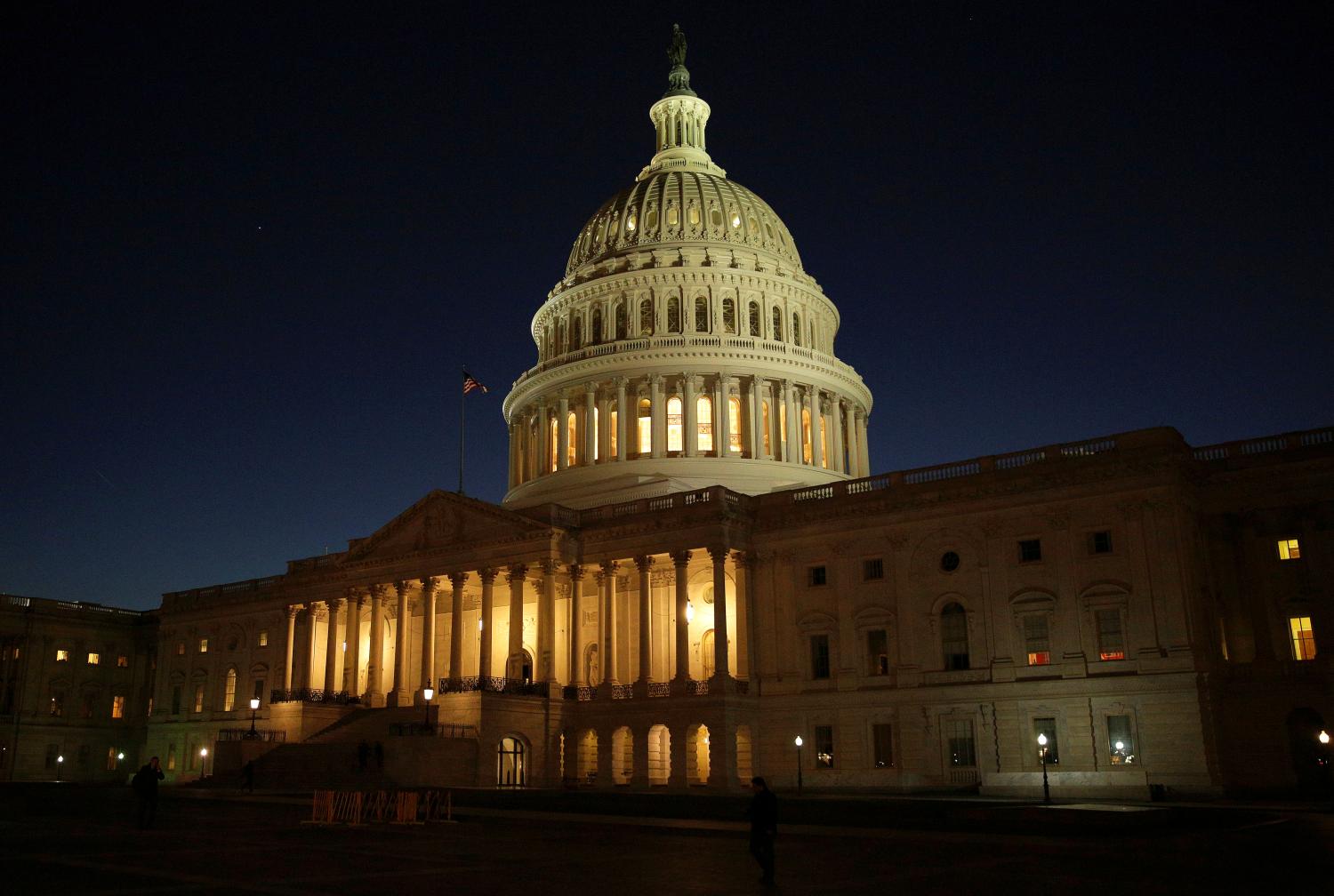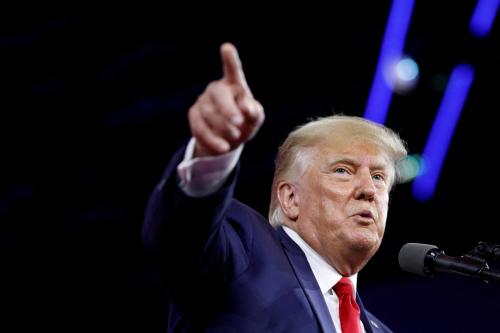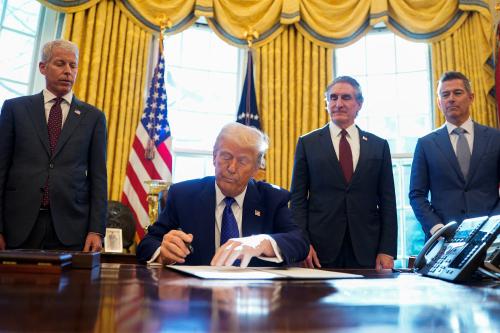In West Virginia v. Environmental Protection Agency (EPA), the Supreme Court has struck down the never-executed centerpiece of the Obama administration’s climate policy: the Clean Power Plan, a set of rules governing fossil-fuel-fired electric generators. Just as importantly, Chief Justice John Roberts, writing for a 6-3 majority, announced in no uncertain terms that the basis for the Court’s decision was the “Major Questions Doctrine” (MQD)—a phrase no Supreme Court majority had previously invoked explicitly.
As Roberts writes, the MQD “label” has now taken “hold because it refers to an identifiable body of law that has developed over a series of significant cases all addressing a particular and recurring problem: agencies asserting highly consequential power beyond what Congress could reasonably be understood to have granted.”1 Rather than treating such assertions of power as normal statutory interpretations, in which judges are highly deferential to agency choices, courts are to approach extraordinary, novel actions with far-reaching consequences with a greater degree of skepticism. If Congress wishes to effect a sweeping overhaul of the nation’s economic activity, it must do so quite explicitly—with a “clear congressional authorization,” in Roberts’ phrasing. Agencies may not, on their own initiative, transform a statutory scheme hitherto used for one thing to perform some other ambitious work, even if the law’s language makes their statutory interpretation “colorable.”
Justice Elena Kagan, writing in dissent, sees Congress as having used “capacious terms” in the section at issue to give the Environmental Protection Agency great discretion in fashioning its emissions reduction scheme. She claims that the purported precedential basis for the MQD is no such thing but is rather just a series of decisions in which the court performed “normal statutory interpretation.” She insists that in approaching an old statute, “newness” of application “might be perfectly legitimate—even required.” According to her, respecting the broad grant of power made by earlier congresses is the appropriate way to respect legislative intent. In a sharply critical passage, she claims that “The current Court is textualist only when being so suits it. When that method would frustrate broader goals, special canons like the ‘major questions doctrine’ magically appear as get-out-of-text-free cards.”
In the run-up to the release of this opinion, many commentators suggested that the court’s conservatives were about to revolutionize American administrative law, such that agencies would find themselves much more constrained in issuing regulations responsive to current problems. Now that the opinion is out, many accuse the Court’s conservatives of creating an unpredictable regime that is “not pro-democracy, it’s anti-regulation,” in the words of Professor Steve Vladek.
In this research note, I explore the history of the MQD to explain why such charges are mistaken, and why the doctrine is not nearly as open-ended as its critics, including Justice Kagan, imply. Properly understood, the MQD strikes a blow for the ongoing vitality of representative government, without posing any serious threat to the potency of American regulation.
History of the Major Questions Doctrine
The MQD is a relatively recent innovation in the Supreme Court’s approach to statutory interpretation. It has been articulated (without generally being explicitly named) in fewer than a dozen cases, and as discussed below, there is an extensive debate as to the doctrine’s implications—one that will, no doubt, persist even after West Virginia v. EPA has been decided.
The basic idea of the MQD is easy enough to state: courts should be skeptical whenever an executive agency interprets a law to empower itself in an extraordinary or novel manner, withholding the deference that agencies customarily receive when interpreting ambiguous statutory language. If the executive branch is going to take a transformative action, it must show that legislators clearly intended to enable that action, and not merely that they once enacted statutory language that could be plausibly read to include it. Failing that, courts should block the action. Legislators, if they choose to, can respond by passing a clear authorization.
Prior to its clear announcement in West Virginia, this idea was encapsulated in several key phrases that MQD cases have repeatedly cited. Striking down a rule of the Occupational Safety and Health Administration in a plurality opinion in the Benzene Case (1980), Justice John Paul Stevens wrote: “In the absence of a clear mandate in the Act, it is unreasonable to assume that Congress intended to give the Secretary the unprecedented power over American industry.” In finding that the Food and Drug Administration had over-interpreted its authority in asserting its jurisdiction over tobacco products, Justice Sandra Day O’Connor wrote: “[W]e are confident that Congress could not have intended to delegate a decision of such economic and political significance to an agency in so cryptic a fashion” (FDA v. Brown & Williamson Tobacco Corp., 2000).2 In Whitman v. American Trucking Associations (2001), Justice Antonin Scalia wrote: “Congress, we have held, does not alter the fundamental details of a regulatory scheme in vague terms or ancillary provisions—it does not, one might say, hide elephants in mouseholes.” The per curiam majority in one of the most recent MQD cases, Alabama Association of Realtors v. HHS (2021), rejected the proposed statutory backing of a sweeping national eviction moratorium as “a wafer-thin reed on which to rest such sweeping power.”
If the basic thrust of these formulations is clear, however, the practical reach of the MQD is difficult to state with confidence. Just how “clear” must a statute be to establish that Congress intended to endow an agency with the power to address some problem? And how consequential must a policy be to qualify as “major”—is economic impact the relevant metric, or might some other aspect of political salience also qualify?
Is the Major Questions Doctrine merely a pretext for conservative judges to stop agency actions?
Given the unresolved nature of these questions, some scholars see the MQD as basically an empty vessel, to be filled up opportunistically with judges’ own preferences. In their telling, conservative justices are opposed to ambitious regulatory actions even when Congress has clearly authorized them, and the MQD gives them an excuse to make themselves into a veto point in the policymaking process even where nothing about their competence as judges makes them suited for the role. Professor Dan Farber, for example, asks, “Doesn’t the major questions doctrine involve the Court itself in making decisions that are far more suited to legislators than courts?” Similarly, Professor David Driesen charges that when justices claim that they are preserving major questions for legislators to decide, they are actually just setting themselves up to “usurp the policy decisions of the elected branches of government.”
From these characterizations, one might think that the MQD has exclusively been invoked by conservative justices seeking to frustrate Democratic administrations, but that is not the case. The Supreme Court has sometimes invoked the MQD to strike down decisions of Republican administrations. Indeed, the first case to clearly style the MQD involved striking down decisions made by the Federal Communications Commission during the Reagan and Bush 41 administrations (MCI v. AT&T, 1994). A later case saw a mostly liberal majority striking down an attempt by the Bush 43 administration to use federal drug laws to prevent assisted suicide (Gonzalez v. Oregon, 2006).
Nor has invocation of the MQD invariably led to the justices striking down an action. In American Trucking, the Court ruled on behalf of the Environmental Protection Agency, rejecting a challenge to its National Ambient Air Quality Standards. Justice Scalia’s opinion for the unanimous court invoked the MQD in defense of the agency’s interpretation, which it found required the least guessing about what Congress might have meant. Even more significantly, in King v. Burwell (2015), Chief Justice John Roberts invoked the MQD to explain why deference to the Internal Revenue Service’s interpretation would be an inappropriate way to decide the question of whether federal tax credits should be made available to participants in federal healthcare exchanges. Given the huge importance of the question involved, Roberts said that it was implausible that Congress meant to leave the question to the discretion of the IRS. Nevertheless, he found that the best reading of the statute supported the provision of subsidies, giving the Obama administration a significant win, locking in an important provision of the Affordable Care Act such that it could not be reversed in a future Republican administration. As I discussed in a Brookings piece in 2015, in that case it was the dissenting conservative justices (Scalia, Thomas, and Alito) who denounced judicial usurpation, dismissing the idea of realizing Congress’ true intent as an inappropriate reason to depart from the most natural reading of the statutory text.
The MQD should not be dismissed as the exclusive province of conservatives, then, nor should it be assumed that any invocation of the doctrine will lead to a reversal of agency policy.
How the Major Questions Doctrine relates to the Nondelegation Doctrine
Some articulations of the MQD have nevertheless left room to wonder whether the doctrine was being fashioned to enable a frontal assault on America’s regulatory state—one that would not just force questions onto the contemporary Congress but significantly limit the legislature’s ability to delegate important matters to executive agencies even when majorities are determined to do so.
That approach was most clearly outlined in two opinions by Justice Neil Gorsuch—his dissent in Gundy v. United States (2019) and his concurrence in NFIB v. OSHA (2022), the case striking down the Biden administration’s vaccine mandate on large employers. In his 2019 dissent, Gorsuch explained that the Court must, one way or another, ensure that Congress does not delegate the legislative power, which the Constitution gives to it alone, to the executive. In the past, it has relied on the “intelligible principle” doctrine to do so. Under that rule, courts must strike down as impermissible any law that endows an agency with an open-ended mission to go out and do good in its respective field. But over time that doctrine became a perfunctory, near-meaningless test, and the Court has sought other tools to combat impermissible delegations. Gorsuch characterizes the MQD as one such tool, applied “in service of the constitutional rule that Congress may not divest itself of its legislative power by transferring that power to an executive agency.” In his 2022 concurrence, he further explicates the role of the MQD as complementary to the nondelegation doctrine. Whereas the latter prevents Congress from intentionally giving away its own power, the MQD “guard[s] against unintentional, oblique, or otherwise unlikely delegations of the legislative power.”
Gorsuch’s concurrence in West Virginia v. EPA, joined by Justice Samuel Alito, rearticulates and clarifies this position. As Gorsuch sees it, the ultimate basis for the MQD is the constitutional requirement that Congress be the branch that makes policy decisions. By seeking “to exploit some gap, ambiguity, or doubtful expression in Congress’s statutes to assume responsibilities far beyond its initial assignment,” agencies may try to undermine that fundamental stricture, and the courts must stop them.
The problem with this “strong” articulation of the MQD, as Gorsuch’s critics see it, is that there is no obvious limiting principle; armed with this sort of skepticism, the Court seems poised to make it impossible for Congress to set up a statutory framework capable of responding to developing circumstances, since super-clarity at the time of drafting seems to be required. In his concurrence, Gorsuch attempts to address such concerns, enumerating the relevant criteria for invocation of the MQD: great political significance, great economic impact, or impinging on an area traditionally left to state law. He then offers other criteria for clarity: a provision should be prominent within a statutory scheme, not a “gap-filler”; a statute’s age and history of usage may clarify its proper limits; and the agency’s own past usage may suggest the appropriate reading of a provision. Not surprisingly, however, Justice Kagan and others are unconvinced that these lists really decide anything.
Time is of the essence
If that conception of the MQD seems to ready it as an anti-democratic counterweight against ambitious legislation, there are nevertheless other ways to understand the doctrine that clarify how and why it is meant to enhance democratic control and the legitimacy of our regulatory policymaking. One focuses on the role of the passage of time in complicating our interpretation of statutory laws.
Professor Jonathan Adler has explained this position most clearly.
We live in a dynamic world, yet our statutes are stagnant. As the world changes and popular understanding of contemporary problems evolves, statutes remain in place. New problems emerge, preexisting problems metastasize, and our understanding of present and prospective problems improves. Yet statutes are infrequently amended to account for these changes.3
One way to understand the MQD is an attempt to combat an interpretive approach that might otherwise amount to “Congress legislating now the power for an agency to legislate later,” especially in contexts where changing facts on the ground mean that foresight of current circumstances was impossible.
Adler points to a formulation made by Justice Kavanaugh when he was still a member of the D.C. Circuit Court of Appeals, the “major rules doctrine.” In judging whether the Obama administration’s famous Net Neutrality rule, promulgated by the Federal Communications Commission, was permissible, Kavanaugh argued that there must be a presumption against Congress making a freestanding endowment of power to the executive branch. Given that the congresses that passed the legislation being used to justify the rule operated without any knowledge whatsoever of the relevant policy environment, it should have been impossible to overcome that presumption. Adler points out that a discussion of the aging and obsolescence of statutes could aid this logic, although Kavanaugh did not explicitly invoke those points.
Does this mean that courts should block all instances of “teaching old laws new tricks”? At the very least, it means that as a statute becomes more antique, the burden for justifying some new action based on its language should get higher. That does not necessarily mean that a law should be “use it or lose it,” since Congress might well wish to empower an agency to deal with some definite-but-rarely-occurring set of circumstances, such as a pandemic. But it would mean that if Congress wants its endowments of power to age well, it needs to take more care to identify the exact purposes and limits of its delegations.
Major questions as articulated in West Virginia v. EPA
Roberts’s opinion in West Virginia v. EPA does a great deal to support this time-sensitive version of the MQD. In determining the proper understanding of Section 111(d) of the Clean Air Act, which was the EPA’s basis for promulgating its ambitious Clean Power Plan, the court’s majority leans heavily on the way that section had been used in the many decades of its existence until 2015. Quoting Justice Felix Frankfurter’s opinion in FTC v. Bunte Brothers (1941), the Chief Justice argues that “the want of assertion of power by those who presumably would be alert to exercise it” can be significant evidence that the statutory provision in question was not, in fact, meant to support such an assertion.4 The EPA’s long usage of 111(d) in ways that looked nothing like the Clean Power Plan stood as a powerful point against the propriety of the novel usage. As in Utility Air Regulatory Group, which also dealt with greenhouse gas issues under the Clean Air Act, the court was especially sensitive to the EPA’s “claim to discover in a long-extant statute an unheralded power.” Had the Clean Air Act been recently enacted or amended, instead of remaining virtually unchanged in the three decades since the Clean Air Act Amendments of 1990, the court’s willingness to see it used to launch an ambitious new program might well have been different.
This may seem to present something of a puzzle. Aren’t the conservatives on the court supposed to be committed to originalism on the Constitutional side and textualism on the statutory side—two doctrines which are against the idea that the meaning of words evolves with the times? If correct legal interpretations are supposed to be a function of unchanged statutory language, then how could they change or be time-sensitive?
It may be fair to note some inconsistency here. To the extent that conservative jurists have followed the late Justice Antonin Scalia in his vehement denunciation of legislative history as an appropriate type of evidence for understanding statutory meaning, the Major Questions Doctrine is indeed an awkward fit in its insistence that judges look beyond the immediately apparent meaning of the text. Conservatives should not hesitate to learn from Scalia’s critical interlocutors, such as the late Judge Bob Katzmann (who was, for many years, a scholar at Brookings), in approaching legislative history.
More fundamentally, however, conservatives’ insistence on unchanging textual meaning does not, in itself, resolve questions about what to do with vague provisions. As Justice Kagan put it, “capacious terms” are meant to create discretion that might be utilized differently at one time or another—but there is no need to read them to create completely unconstrained discretion. What the MQD amounts to is an insistence that, under our overarching Constitutional system, it would be preposterous to imagine any Congress intending to create such an open-ended grant of authority, capable of justifying a significant reordering of society in later, unforeseen circumstances.
The basic point of disagreement between the majority and the dissent, and perhaps between most conservative and liberal legal scholars considering the contemporary regulatory state, is over the following question: Is a reservoir of regulatory authority created by old enactments a sufficient basis for justifying novel and far-reaching regulatory actions today?
In answering “no,” the Court explicitly demands that our representative legislature must continue to assert itself to orient our federal government’s responses to the leading challenges of our time. In no other way, it suggests, can our laws retain their legitimacy with the public. In answering “yes,” Kagan and the dissenters claim to be honoring the fundamental continuity of the people’s exercise of their sovereign power. In their view, the contemporary legislature could always assert itself to change the direction of regulatory power, but it need not do so for the country to adapt to new circumstances.
For those who see the democratic legitimacy of the contemporary Congress as hopelessly compromised, there is little question that the dissent’s view makes more sense. For those of us who believe that the renewed exertions of our legislators are the only means capable of securing policy legitimacy and stability, the majority’s view represents a fitting commitment to Constitutional self-government.
-
Footnotes
- West Virginia v. EPA (2022), p. 20 of the Court’s slip opinion.
- Notably, O’Connor also cited a 1986 law review article by then-Judge Stephen Breyer, in which he explained that “A court may also ask whether the legal question is an important one. Congress is more likely to have focused upon, and answered, major questions, while leaving interstitial matters to answer themselves in the course of the statute’s daily administration.”
- Adler, Jonathan H. “A ‘Step Zero’ for Delegations.” The Administrative State before the Supreme Court (Washington, D.C.: American Enterprise Institute, 2022): 161–94, 167.
- Slip op., at 21.
The Brookings Institution is committed to quality, independence, and impact.
We are supported by a diverse array of funders. In line with our values and policies, each Brookings publication represents the sole views of its author(s).








